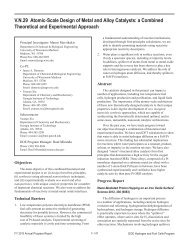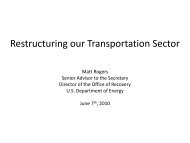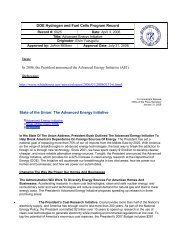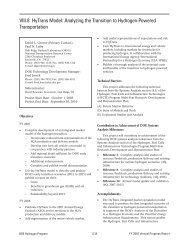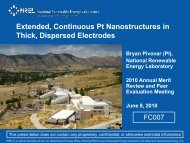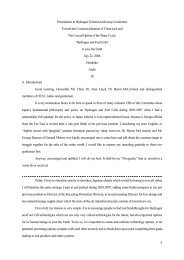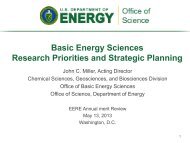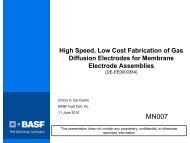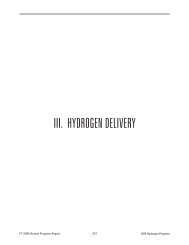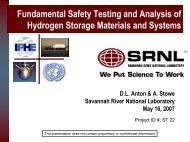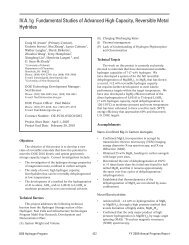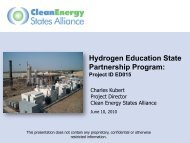Fuel Cell-Powered Lift Truck FedEx Freight Fleet Deployment - DOE ...
Fuel Cell-Powered Lift Truck FedEx Freight Fleet Deployment - DOE ...
Fuel Cell-Powered Lift Truck FedEx Freight Fleet Deployment - DOE ...
You also want an ePaper? Increase the reach of your titles
YUMPU automatically turns print PDFs into web optimized ePapers that Google loves.
XII.9 <strong>Fuel</strong> <strong>Cell</strong>-<strong>Powered</strong> <strong>Lift</strong> <strong>Truck</strong> <strong>FedEx</strong> <strong>Freight</strong> <strong>Fleet</strong> <strong>Deployment</strong><br />
Jonathan King<br />
<strong>FedEx</strong> <strong>Freight</strong><br />
2200 Forward Drive<br />
Harrison, AR 72601<br />
Phone: (870) 391-4149 ext. 2022<br />
E-mail: jonathan.king@fedex.com<br />
<strong>DOE</strong> Managers:<br />
HQ: Dimitrios Papageorgopoulos<br />
Phone: (202) 586-5463<br />
E-mail: dimitrios.papageorgopoulos@ee.doe.gov<br />
GO: David Peterson<br />
Phone: (720) 356-1747<br />
E-mail: david.peterson@go.doe.gov<br />
Contract Number: DE-EE0000482<br />
Subcontractors:<br />
• Plug Power Inc., Latham, NY<br />
• Air Products and Chemicals, Inc., Allentown, PA<br />
Project Start Date: October 1, 2009<br />
Project End Date: September 30, 2013<br />
Objectives<br />
The objectives of this project are to:<br />
• Convert an entire fleet of 35 class-1 electric lift trucks<br />
to hydrogen fuel cells at the <strong>FedEx</strong> <strong>Freight</strong> facility in<br />
Springfield, MO.<br />
• Demonstrate the safe and reliable operation of<br />
hydrogen-fueled material handling equipment (MHE).<br />
• Demonstrate the economic benefits of conversion to<br />
hydrogen fuel cell-powered MHE.<br />
• Demonstrate operator acceptance of hydrogen fuel cellpowered<br />
MHE.<br />
• Provide a cost-effective and reliable hydrogen fuel<br />
supply.<br />
• Spur further lift truck fleet conversions to hydrogen fuel<br />
cells.<br />
• Establish a proving ground for hydrogen fuel cellpowered<br />
MHE.<br />
Relevance to the American Recovery and Reinvestment<br />
Act (ARRA) of 2009 Goals<br />
This project advances the goals of the ARRA of 2009<br />
to create new jobs, save existing jobs, and spur economic<br />
activity and investment in long-term economic growth by:<br />
• Creating jobs at Plug Power to design, build and<br />
commission the fuel cell power units.<br />
• Creating jobs at Air Products to design, install and<br />
commission hydrogen storage and fueling equipment.<br />
• Creating jobs at Air Products to deliver hydrogen to the<br />
<strong>FedEx</strong> <strong>Freight</strong> Springfield, MO facility.<br />
• Training <strong>FedEx</strong> <strong>Freight</strong> lift truck operators in hydrogen<br />
safety, fueling procedures and fuel cell operation.<br />
• Training <strong>FedEx</strong> <strong>Freight</strong> lift truck maintenance personnel<br />
to service fuel cells.<br />
• Improving the overall economic efficiency of material<br />
handling operations.<br />
This project advances the <strong>DOE</strong> <strong>Fuel</strong> <strong>Cell</strong> Technologies’<br />
ARRA project goals of accelerating the commercialization<br />
and deployment of fuel cells and fuel cell manufacturing,<br />
installation, maintenance, and support services by<br />
demonstrating:<br />
• Safe and reliable operation of hydrogen storage and<br />
fueling equipment and fuel delivery.<br />
•<br />
Reliable and efficient operation of hydrogen fuel cells.<br />
• Economic and environmental advantages of fuel cells<br />
over batteries.<br />
•<br />
Practical operation and maintenance of fuel cells.<br />
Technical Barriers<br />
This project addresses the following technical barriers to<br />
the use of fuel cell powered lift trucks:<br />
•<br />
•<br />
Repair frequency of hydrogen fuel cells.<br />
Cold weather operation of hydrogen fuel cells.<br />
• Cold weather operation of hydrogen storage and fueling<br />
equipment.<br />
Technical Targets and Milestones<br />
The technical targets and milestones of this project include:<br />
• Installing hydrogen storage and fueling equipment by<br />
May 2010.<br />
•<br />
Developing a hydrogen safety plan by May 2010.<br />
• Commissioning 35 class-1 power units by December<br />
2009.<br />
•<br />
•<br />
Completing startup and training by June 2010.<br />
Starting operation and evaluation by July 2010.<br />
Accomplishments<br />
The accomplishments of this project include:<br />
• Commissioning 35 GenDrive class-1 power units by<br />
December 2009.<br />
<strong>DOE</strong> Hydrogen and <strong>Fuel</strong> <strong>Cell</strong>s Program<br />
1316<br />
FY 2011 Annual Progress Report
King – <strong>FedEx</strong> <strong>Freight</strong><br />
XII. ARRA<br />
• Commissioning hydrogen storage and fueling equipment<br />
by June 2010.<br />
• Completing all fueling, operation and maintenance<br />
training by June 2010.<br />
• Purchasing and commissioning an additional five<br />
GenDrive class-1 power units in December 2010<br />
(without <strong>DOE</strong> funding).<br />
• Determining that problems with air-actuated valves<br />
during cold-weather operation of the hydrogen storage<br />
and fueling system were caused by excessive moisture in<br />
the air supply.<br />
• Modifying lift trucks to prevent drive-offs that damaged<br />
the hydrogen fueling hose.<br />
• Logging over 48,000 hours of fuel cell operation by the<br />
end of July.<br />
• Purchasing 18,300 kilograms of hydrogen by the end of<br />
July.<br />
• Monitoring operating costs and reliability of<br />
40 GenDrive power units (ongoing).<br />
• Demonstrating 30-60% more operating hours per repair<br />
for fuel cells compared to propane lift trucks between<br />
July 2010 and February 2011.<br />
Introduction<br />
G G G G G<br />
The purpose of this project is to demonstrate that<br />
hydrogen fuel cells are a safe and economical alternative<br />
to batteries for powering electric lift trucks. The primary<br />
barriers to widespread use of hydrogen fuel cells for material<br />
handling equipment are concerns about the safety of<br />
hydrogen storage and fueling equipment, operating costs for<br />
fuel and maintenance, and the long-term reliability of fuel<br />
cells.<br />
Approach<br />
This project evaluates the safety and economics of using<br />
hydrogen fuel cells to power a fleet of 35 class-1 electric<br />
lift trucks at the <strong>FedEx</strong> <strong>Freight</strong> facility in Springfield, MO.<br />
<strong>FedEx</strong> <strong>Freight</strong> supplies the lift trucks, Plug Power supplies<br />
the GenDrive fuel cell power units and Air Products supplies<br />
the hydrogen fuel and the hydrogen storage and fueling<br />
equipment. The fuel cell equipment is maintained by <strong>FedEx</strong><br />
<strong>Freight</strong> personnel with assistance from Plug Power and<br />
Air Products personnel when necessary. Plug Power and<br />
Air Products also assisted <strong>FedEx</strong> <strong>Freight</strong> in developing a<br />
comprehensive hydrogen safety plan.<br />
Previous <strong>FedEx</strong> <strong>Freight</strong> field trials with a limited number<br />
of GenDrive power units demonstrated productivity gains<br />
and improved performance compared to battery-powered<br />
lift trucks. The lift truck fleet conversion in Springfield is<br />
expected to demonstrate improved operational efficiencies<br />
and help the environment by reducing greenhouse<br />
gas emissions and the use of toxic battery materials.<br />
A successful demonstration of these advantages at the<br />
Springfield facility could lead to additional fleet conversions<br />
at other <strong>FedEx</strong> <strong>Freight</strong> facilities.<br />
The Hydrogen Safety plan has been completed and<br />
reviewed. The changes to the safety plan are in the process<br />
of being made.<br />
The National Environmental Policy Act forms were<br />
submitted to the <strong>DOE</strong>. There are no outstanding National<br />
Environmental Policy Act requirements. The project was<br />
granted a categorical exclusion determination prior to the<br />
project commencing.<br />
Results<br />
To date, this project has successfully demonstrated<br />
the safe and economical operation of 40 GenDrive class-1<br />
power units and associated hydrogen storage and fueling<br />
equipment. The power units have accumulated over<br />
48,000 hours of operation and consumed 18,300 kilograms<br />
of hydrogen.<br />
A few problems occurred during cold-weather<br />
operation. Problems with air-actuated valves in the<br />
hydrogen storage and fueling system were caused by<br />
excessive moisture in the air supply. Problems with the<br />
power units were resolved by adding thermal insulation to<br />
sensitive components.<br />
<strong>Fuel</strong>ing hoses were damaged on two occasions when<br />
lift trucks were driven away from the fueling station while<br />
the fueling hoses were still attached to the lift truck. The lift<br />
trucks were subsequently modified to prevent them being<br />
driven while the fueling hoses were attached.<br />
<strong>FedEx</strong> <strong>Freight</strong> found that the fuel cell-powered lift<br />
trucks at the Springfield facility had 63% more hours of<br />
operation per repair (115.2 hours/repair) compared to<br />
similar propane-powered lift trucks at the South Dallas<br />
facility (70.5 hours/repair) and 30% more hours of operation<br />
per repair compared to propane lift trucks at all <strong>FedEx</strong><br />
<strong>Freight</strong> facilities (88.3 hour/repair).<br />
Figure 1 shows a breakdown of the types of fuel cell<br />
repairs. Instrumentation and control (35%), cooling<br />
(16%), hydrogen (13%), and humidification (11%) systems<br />
accounted for 75% of all repairs. Figure 2 shows that 74%<br />
of all repairs required less than two hours of labor. Figure 3<br />
shows that 35% of all fuel cell repairs to date have occurred<br />
during the first 100 hours of operation.<br />
Based on the favorable operational results with<br />
the initial 35 power units, <strong>FedEx</strong> <strong>Freight</strong> purchased an<br />
additional five power units in December 2010 without <strong>DOE</strong><br />
funding.<br />
FY 2011 Annual Progress Report<br />
1317<br />
<strong>DOE</strong> Hydrogen and <strong>Fuel</strong> <strong>Cell</strong>s Program
XII. ARRA<br />
King – <strong>FedEx</strong> <strong>Freight</strong><br />
Conclusions and Future Directions<br />
Figure 1. Types of <strong>Fuel</strong> <strong>Cell</strong> Repairs<br />
Frequency<br />
60<br />
50<br />
40<br />
30<br />
20<br />
10<br />
0<br />
0.5 1.0 1.5 2.0 2.5 3.0 3.5 4.0 4.5 5.0 5.5 6.0 6.5 7.0 7.5 8.0 8.5 9.0 9.5 10.0 More<br />
Labor hours for repair<br />
Figure 2. Labor Hours for <strong>Fuel</strong> <strong>Cell</strong> Repairs<br />
*Average repair time: 1.82 hours<br />
*74% of repairs needed less<br />
than 2 hours of labor<br />
Based on our operational experience to date, hydrogen<br />
fuel cells appear to be a safe and economical alternative to<br />
batteries for electric lift trucks. We will continue to monitor<br />
the long-term costs and reliability of hydrogen fuel cells by:<br />
• Providing ongoing operational and maintenance support<br />
for the GenDrive power units and the hydrogen storage<br />
and fueling equipment.<br />
• Collecting data from the power units to evaluate<br />
performance, operability and safety.<br />
• Collecting data from the hydrogen storage and fueling<br />
equipment to evaluate performance, operability and<br />
safety.<br />
• Resolving cold-weather operation problems with airactuated<br />
valves in the hydrogen storage and fueling<br />
equipment.<br />
• Working with Plug Power to resolve cold-weather<br />
operation problems with fuel cells.<br />
FY 2011 Publications/Presentations<br />
1. Held an official ribbon-cutting ceremony in October 2010 to<br />
inaugurate the hydrogen fuel cell project at the <strong>FedEx</strong> <strong>Freight</strong><br />
service center in Springfield, MO.<br />
2. Delivered an American Recovery and Reinvestment Act merit<br />
review presentation in Washington, DC in May 2011.<br />
3. Contributed a synopsis of project progress to the <strong>DOE</strong>’s<br />
Energy Empowers blog.<br />
<strong>Fuel</strong> <strong>Cell</strong> Repairs - %<br />
35<br />
30<br />
25<br />
20<br />
15<br />
10<br />
5<br />
0<br />
35% of all repairs occurred in the first<br />
100 hours of fuel cell operation<br />
200 400 600 800 1,000 1,200<br />
<strong>Fuel</strong> <strong>Cell</strong> Run Time - Hours<br />
Figure 3. <strong>Fuel</strong> <strong>Cell</strong> Repair Frequency vs. Run Time<br />
<strong>DOE</strong> Hydrogen and <strong>Fuel</strong> <strong>Cell</strong>s Program<br />
1318<br />
FY 2011 Annual Progress Report



